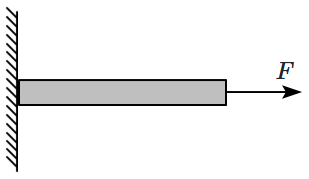A man transforms into a giant such that all his linear dimensions become \(9\) times their original values. Assuming his density remains unchanged, the stress on his legs changes by a factor of:
| 1. | \(9\) | 2. | \(\dfrac{1}{9}\) |
| 3. | \(81\) | 4. | \(\dfrac{1}{81}\) |
| 1. | \(5.2\times10^{6}~\text{N/m}^{2}\) | 2. | \(6.2\times10^{6}~\text{N/m}^{2}\) |
| 3. | \(4.8\times10^{6}~\text{N/m}^{2}\) | 4. | \(3.1\times10^{6}~\text{N/m}^{2}\) |
In an experiment, brass and steel wires of length \(1~\text{m}\) each with areas of cross section \(1~\text{mm}^2\) are used. The wires are connected in series and one end of the combined wire is connected to a rigid support and other end is subjected to elongation. The stress required to produce a net elongation of \(0.2~\text{mm}\) is, [Given, the Young's Modulus for steel and brass are, respectively, \(120 \times 10^9 ~\text{N/m}^2\) and \(60 \times 10^9 ~\text{N/m}^2\)]
1. \( 4.0 \times 10^6 ~\text{N/m}^2\)
2. \( 1.2 \times 10^6~\text{N/m}^2\)
3. \( 1.8 \times 10^6~\text{N/m}^2\)
4. \(8 \times 10^6~\text{N/m}^2\)
The elastic limit of brass is 400 MPa. What should be the minimum diameter of a brass rod if it is to support a 400\(\pi \) N load without exceeding its elastic limit?
1. 1 mm
2. 1.5 mm
3. 2 mm
4. 2.5 mm
(Breaking stress of wire = \(4.8 \times 10^7 ~\text{Nm}^{-2}\) and area of cross-section of the wire = \(10^{-2}~ \text {cm}^{-2}\))
1. \(4~\text{rad s}^{-1}\)
2. \(6~\text{rad s}^{-1}\)
3. \(8~\text{rad s}^{-1}\)
4. \(9~\text{rad s}^{-1}\)
A uniform metallic wire is elongated by \(0.04\) m when subjected to a linear force \(F\). The elongation, if its length and diameter are doubled and subjected to the same force will be:
| 1. | \(1\) cm | 2. | \(2 \) cm |
| 3. | \(3\) cm | 4. | \(6\) cm |
1. \(6.25\times10^{-4}~\text{m}^2\)
2. \(10\times10^{-4}~\text{m}^2\)
3. \(1\times10^{-4}~\text{m}^2\)
4. \(1.67\times10^{-4}~\text{m}^2\)
1. \(15\) m/s
2. \(50\) m/s
3. \(25\) m/s
4. \(40\) m/s
(\(F=100\) N, \(A=10\) cm2, \(l=1\) m, \(Y=5\times10^{10}\) N/m2)
1. \(10^{-6}\) m
2. \(10^{-5}\) m
3. \(2\times10^{-6}\) m
4. \(2\times10^{-5}\) m

1. \(2.5\times10^{-3}\)
2. \(2.5\times10^{-4}\)
3. \(2.0\times10^{-3}\)
4. \(2.0\times10^{-4}\)






